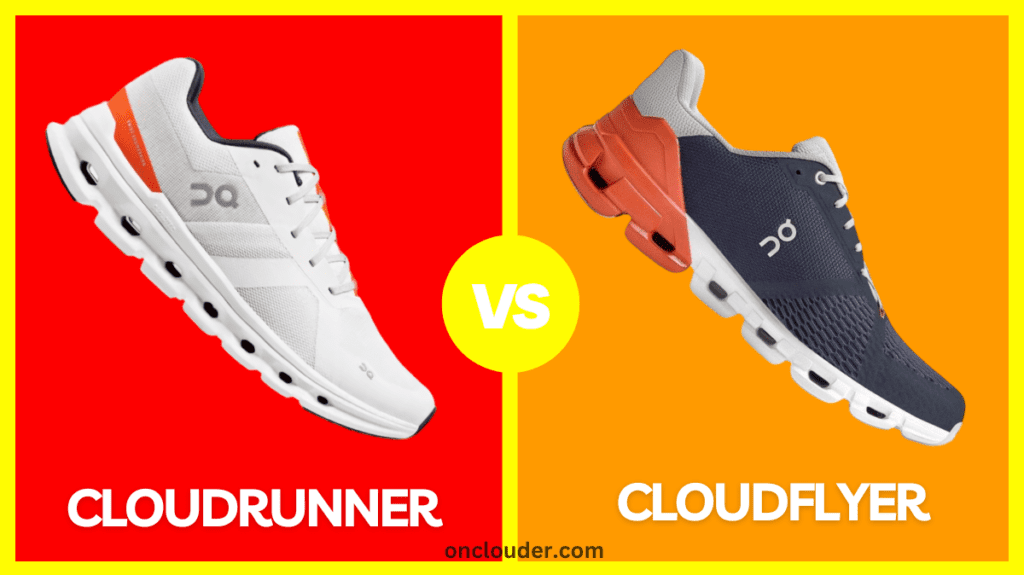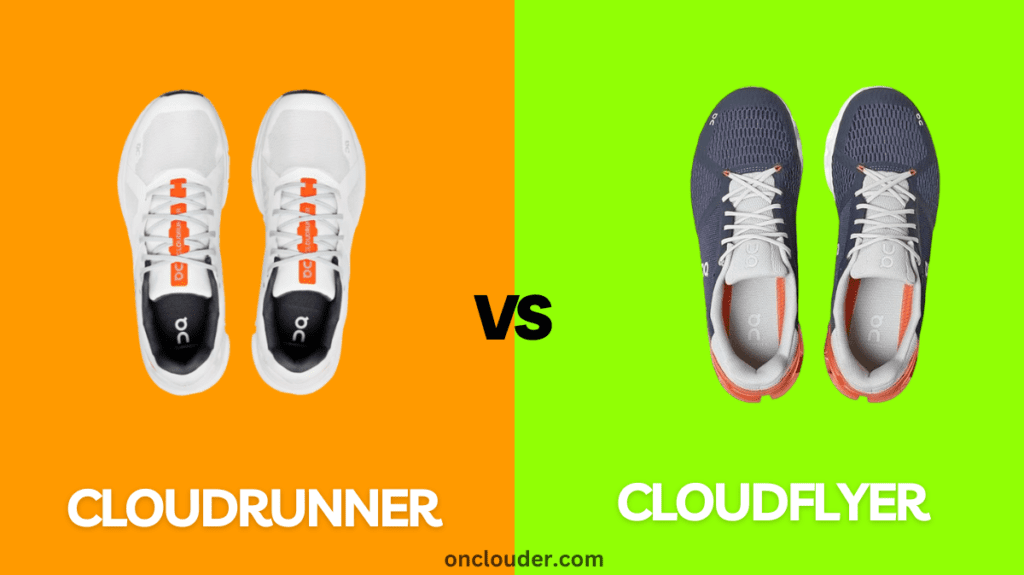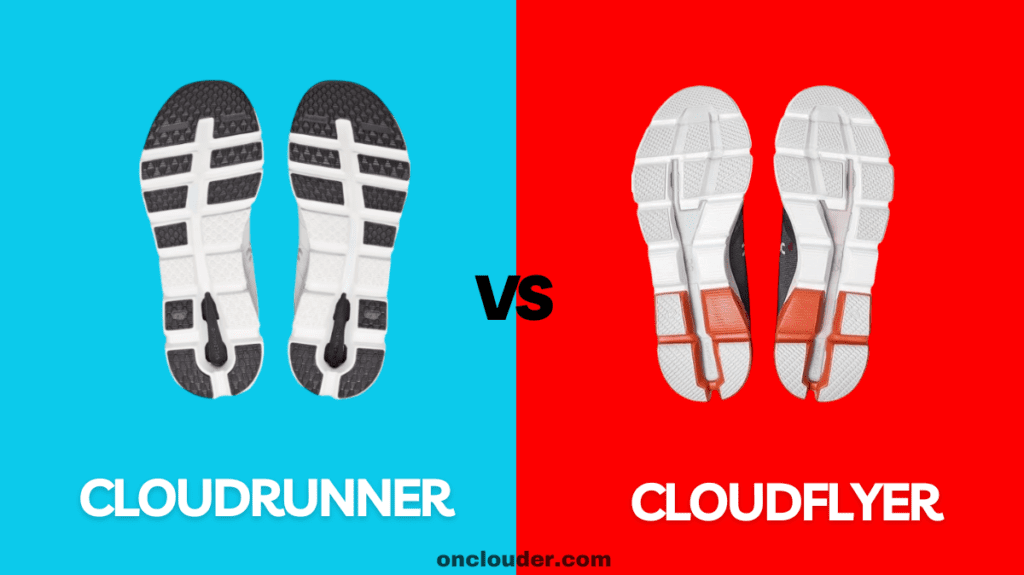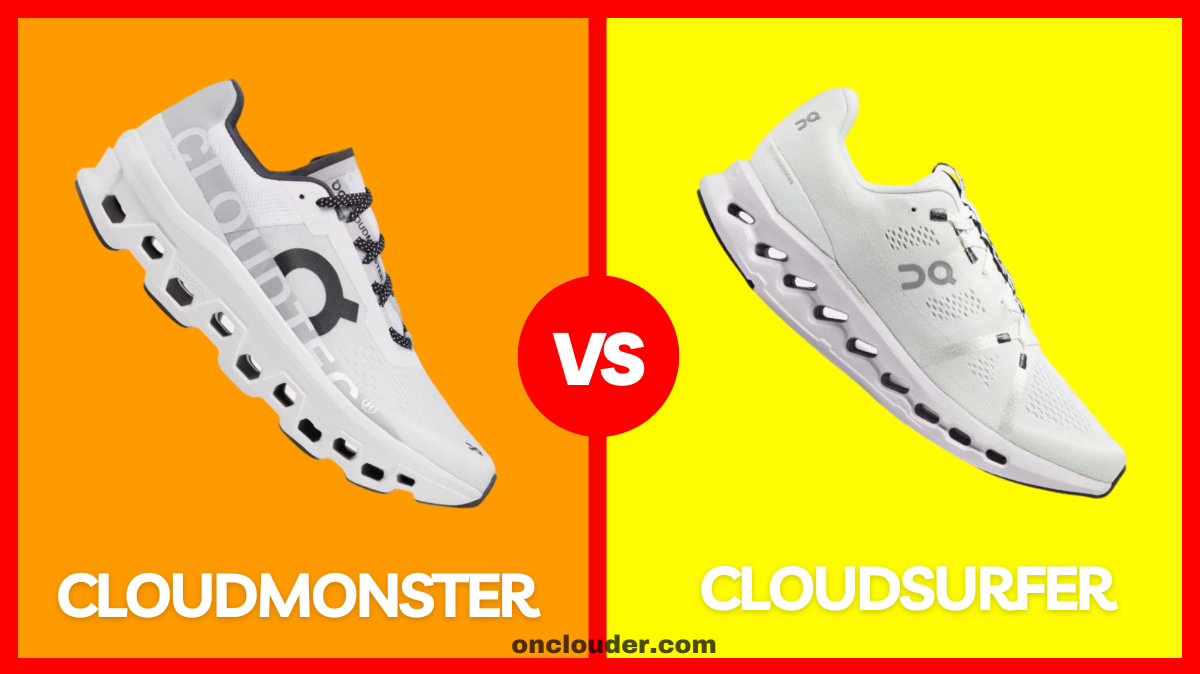In the world of athletic footwear, two titans have emerged, leaving runners and fitness enthusiasts alike in a quandary – Cloudrunner or Cloudflyer?
Both brands have garnered a loyal following, but which one truly reigns supreme?
We’ll dive deep into the nitty-gritty details, exploring everything from durability to style, and everything in between. Get ready, because this is going to be an exhilarating ride!

Contents
- 1 Cloudrunner vs Cloudflyer Shoes
- 2 Which Shoes Perfect for Any Activity
- 3 Durability: Built to Last
- 4 Breathability: Stay Cool and Dry
- 5 Cushioning: Comfort is King
- 6 Shoe Fit: Finding Your Perfect Match
- 7 Materials: What’s Inside Counts
- 8 Weight: Lighter is Better
- 9 Flexibility: Bend With the Best
- 10 Water Resistance: Stay Dry and Comfy
- 11 Sole: Where the Rubber Meets the Road
- 12 User Reviews and Pricing
- 13 Pros and Cons
Cloudrunner vs Cloudflyer Shoes
The main difference between Cloudrunner and Cloudflyer shoes lies in their level of support and intended use. Cloudrunner offers moderate support for everyday runs and is suitable for various foot types.
In contrast, Cloudflyer provides maximum support and stability, designed specifically for overpronators and those needing extra guidance during their runs.
Now, let’s create a detailed comparison table for Cloudrunner vs Cloudflyer Shoes:
| Feature | Cloudrunner | Cloudflyer |
| Cushioning | Moderate | High |
| Weight | Lighter (approx. 250g) | Heavier (approx. 280g) |
| Support | Neutral | Stability |
| Heel-to-toe drop | 9mm | 7mm |
| Best for | Daily training, long runs | Overpronators, long distances |
| Upper material | Engineered mesh | Engineered mesh with reinforced areas |
| Midsole | Helion™ superfoam | Helion™ superfoam |
| Outsole | CloudTec® | CloudTec® with wider landing zone |
| Flexibility | More flexible | Less flexible |
| Breathability | High | Moderate |
| Durability | Good | Very good |
| Price range | Slightly lower | Slightly higher |
| Ideal pace | Faster | Moderate to slow |
| Foot type | Normal to high arches | Low to normal arches |
| Terrain | Road, track | Road, light trails |
Summary: The Cloudrunner is a lighter, more flexible shoe designed for neutral runners who prefer a responsive feel for daily training and long runs. It offers moderate cushioning and is suitable for faster paces.
The Cloudflyer, on the other hand, is a stability shoe that provides more support and cushioning, making it ideal for overpronators and those who need extra comfort during long distances.
Also Read: Cloud Monster vs On Cloudboom Echo 3
Which Shoes Perfect for Any Activity
For Running
Cloudrunner
- Versatile shoe suitable for various distances and daily training
- Moderate cushioning with CloudTec® and Helion™ superfoam
- Weight: Typically lighter (exact weight varies by size)
- Neutral support for runners with normal pronation
- Good for moderate paces and everyday runs
Cloudflyer
- Designed for runners needing extra stability and support
- Maximum cushioning with Zero-Gravity foam and CloudTec®
- Weight: Slightly heavier due to additional support features
- Enhanced stability features for overpronators
- Suitable for longer distances and recovery runs
For Walking
Cloudrunner
- Good for walking with responsive cushioning
- Engineered mesh upper provides breathability for longer walks
- Moderate cushioning may be sufficient for most walking needs
Cloudflyer
- Excellent for walking due to its plush cushioning
- Wider base offers increased stability on various surfaces
- Star-lacing system provides a more customized fit for comfort
For Standing All Day
Cloudrunner
- Decent for standing with its moderate cushioning
- Neutral support may be sufficient for those without specific foot issues
- Lighter weight could reduce fatigue over long periods
Cloudflyer
- Superior for standing all day due to maximum cushioning
- Wider platform provides better stability for prolonged standing
- Enhanced cushioning helps reduce foot fatigue over extended periods
- Support features beneficial for those who need extra stability while standing

Durability: Built to Last
Let’s start with the foundation of any good running shoe – durability. After all, what’s the point of investing in a pair of kicks if they can’t withstand the rigors of your active lifestyle?
Cloudrunner: A Marathon of Resilience
Cloudrunner shoes are renowned for their rugged construction and unwavering durability. The brand utilizes top-notch materials, such as high-quality mesh and reinforced stitching, to ensure that their shoes can go the distance, no matter how grueling the workout or how challenging the terrain.
Cloudflyer: Lightweight Longevity
While Cloudflyer shoes may not be as heavy-duty as their Cloudrunner counterparts, they certainly don’t skimp on durability. The brand’s unique blend of synthetic materials and advanced construction techniques result in shoes that are both lightweight and remarkably resilient, capable of withstanding the wear and tear of regular use.
Also Read: Cloudrunner vs Cloudgo
Breathability: Stay Cool and Dry
Nobody likes sweaty, smelly feet – it’s just a fact of life. That’s why breathability is such an essential factor when it comes to choosing the right pair of running shoes.
Cloudrunner: Ventilation Perfected
Cloudrunner understands the importance of keeping your feet cool and dry during even the most intense workouts. Their shoes feature strategically placed mesh panels and perforations that allow for optimal airflow, ensuring that your feet stay fresh and comfortable mile after mile.
Cloudflyer: Airy and Lightweight
Cloudflyer takes a slightly different approach to breathability. Instead of relying heavily on mesh panels, the brand focuses on creating shoes that are incredibly lightweight and airy. The result? Shoes that feel almost like you’re running on clouds, with ample room for your feet to breathe and stay cool, even during the most grueling runs.
Cushioning: Comfort is King
Let’s face it, nobody wants to run in shoes that feel like they’re made of concrete. That’s why cushioning is such a crucial aspect of any good running shoe.
Cloudrunner: Shock Absorption Mastered
Cloudrunner shoes are renowned for their superior cushioning capabilities. The brand’s proprietary midsole technology is designed to absorb shock and provide ample cushioning with every stride, reducing the risk of injury and ensuring a smooth, comfortable ride.
Cloudflyer: Responsive and Resilient
Cloudflyer takes a different approach to cushioning, favoring responsive and resilient materials over bulky midsoles. The brand’s unique foam compounds are designed to provide just the right amount of cushioning, while still maintaining a lightweight and responsive feel, ensuring that you can tackle even the toughest runs with ease.
Shoe Fit: Finding Your Perfect Match
A shoe that doesn’t fit properly is like a bad relationship – it’s just not worth the hassle. That’s why it’s crucial to consider how each brand approaches shoe fit.
Cloudrunner: Customizable Comfort
Cloudrunner understands that every foot is unique, which is why they offer a range of customizable features to ensure a perfect fit. From adjustable lacing systems to removable footbeds, Cloudrunner shoes can be tailored to your specific needs, ensuring a comfortable and secure fit every time you lace up.
Cloudflyer: True to Size
Cloudflyer takes a more straightforward approach to shoe fit, focusing on creating shoes that are true to size and designed to accommodate a wide range of foot shapes and sizes. While they may not offer as many customization options as Cloudrunner, Cloudflyer shoes are known for their consistent and reliable fit, making it easy to find your perfect match right out of the box.

Materials: What’s Inside Counts
The materials used in a running shoe’s construction can have a significant impact on its overall performance, durability, and comfort.
Cloudrunner: Premium Picks
Cloudrunner is known for their unwavering commitment to using only the finest materials in their shoes. From high-quality mesh uppers to advanced synthetic blends, every component of a Cloudrunner shoe is carefully selected to ensure optimal performance and longevity.
Cloudflyer: Innovative Blends
While Cloudflyer may not have the same focus on traditional premium materials as Cloudrunner, they more than make up for it with their innovative use of cutting-edge synthetic blends and recycled materials.
The brand’s commitment to sustainability and forward-thinking design has resulted in shoes that are not only eco-friendly but also incredibly lightweight, breathable, and comfortable.
Also Read: Cloudrunner vs Cloudsurfer
Weight: Lighter is Better
In the world of running, every ounce counts, which is why a shoe’s weight is such an important factor to consider.
Cloudrunner: Solid and Supportive
Cloudrunner shoes are designed with durability and support in mind, which often translates to a slightly heftier weight compared to some of their competitors.
However, don’t let that deter you – the brand’s advanced construction techniques and strategic use of lightweight materials help to offset the overall weight, ensuring that your feet never feel bogged down.
Cloudflyer: Featherlight Freedom
Cloudflyer is all about lightweight performance. Their innovative material blends and minimalist designs result in shoes that feel almost weightless on your feet. Whether you’re tackling speed workouts or logging long-distance miles, Cloudflyer’s featherlight construction will have you feeling like you’re running on air.
Flexibility: Bend With the Best
A running shoe’s flexibility can make all the difference when it comes to comfort, performance, and overall foot health.
Cloudrunner: Supportive Yet Supple
While Cloudrunner shoes are known for their sturdy construction and robust support, they still manage to strike a delicate balance with flexibility. The brand’s advanced midsole technologies and strategically placed flex grooves allow for natural foot movement, while still providing the necessary stability and support.
Cloudflyer: Agile and Adaptable
Flexibility is one of Cloudflyer’s strong suits. The brand’s focus on lightweight, minimalist design results in shoes that are incredibly agile and adaptable, allowing your feet to move naturally and freely. Whether you’re navigating uneven terrain or simply logging miles on the road, Cloudflyer’s flexible construction will keep you feeling nimble and sure-footed.
Water Resistance: Stay Dry and Comfy
Nobody likes soggy, waterlogged shoes, especially when you’re in the middle of a run. That’s why water resistance is such an important factor to consider when choosing your next pair of running shoes.
Cloudrunner: Weather-Ready Warriors
Cloudrunner shoes are designed to take on whatever Mother Nature throws their way. Many of their models feature water-resistant or waterproof materials, as well as strategically placed drainage systems to keep your feet high and dry, even in the face of unexpected downpours or puddles.
Cloudflyer: Lightweight and Breathable
While Cloudflyer shoes may not be as explicitly water-resistant as their Cloudrunner counterparts, their lightweight and highly breathable construction means that they dry out quickly, preventing that dreaded soggy feeling. Additionally, many Cloudflyer models feature water-repellent coatings, providing an extra layer of protection against light rain and moisture.
Also Read: Cloudmonster vs Cloudsurfer
Sole: Where the Rubber Meets the Road
The sole of a running shoe is arguably one of its most critical components, as it’s the part that makes direct contact with the ground and determines your overall traction and grip.
Cloudrunner: Traction and Grip Galore
Cloudrunner shoes are renowned for their high-performance outsoles, which are designed to provide superior traction and grip on a variety of surfaces. Whether you’re tackling technical trails or pounding the pavement, Cloudrunner’s advanced tread patterns and durable rubber compounds ensure that you’ll always have a sure footing.
Cloudflyer: Lightweight and Responsive
Cloudflyer takes a slightly different approach to sole design, favoring lightweight and responsive materials over heavy-duty tread patterns. Their innovative foam compounds and strategically placed flex grooves result in soles that are both cushioned and flexible, providing a smooth and natural ride, no matter where your runs take you.

User Reviews and Pricing
| Brand | Rating | Price Range | User Reviews |
| Cloudrunner | ⭐⭐⭐⭐⭐ | $120 – $180 | “These shoes are a game-changer for my runs. The cushioning is amazing, and they provide excellent stability.” “Durable and long-lasting, I’ve put hundreds of miles on these and they’re still going strong.” |
| Cloudflyer | ⭐⭐⭐⭐⭐ | $90 – $150 | “Lightweight and breathable, these shoes make me feel like I’m running on clouds.” “Great value for money, and they look really stylish too.” “I wish they had a bit more arch support, but overall a solid running shoe.” |
Pros and Cons
Here are the pros and cons of Cloudrunner vs Cloudflyer shoes:
Pros: Cloudrunner
- Versatile for various running distances
- Lighter weight for faster runs
- Responsive cushioning with CloudTec® and Helion™ superfoam
- Good balance of comfort and performance
- Suitable for neutral runners
- Breathable engineered mesh upper
Cons: Cloudrunner
- Less stability for overpronators
- Moderate cushioning may not be enough for long-distance runners
- Not ideal for those needing maximum support
- May wear out faster for heavier runners
Pros: Cloudflyer
- Maximum cushioning for enhanced comfort
- Excellent stability features for overpronators
- Wider base for improved balance
- Star-lacing system for customized fit
- Better for long-distance runs and recovery
- Superior for standing all day
Cons: Cloudflyer
- Heavier than Cloudrunner
- May feel too supportive for neutral runners
- Could be less responsive for speed work
- Potentially warmer due to additional cushioning and support features
- Higher price point due to advanced features
Also Read: Cloudultra vs Cloudultra 2
In conclusion: In the battle between Cloudrunner and Cloudflyer, it’s clear that both brands bring something unique and valuable to the table for runners and fitness enthusiasts alike.
Cloudrunner’s rugged construction, superior cushioning, and uncompromising stability make them an excellent choice for those who demand the utmost in performance and protection, no matter the terrain or distance.
Are Cloudrunner or Cloudflyer shoes better for long-distance running?
Both brands offer excellent options for long-distance running, but Cloudrunner’s superior cushioning and support might be better suited for those tackling marathon distances or ultra-long runs, while Cloudflyer’s lightweight and responsive design could be more advantageous for shorter distances or speed work.
Can Cloudrunner or Cloudflyer shoes be used for activities other than running?
Absolutely! While both brands are primarily designed with running in mind, their high-quality construction and versatile designs make them suitable for a wide range of activities, from cross-training to casual wear.
How often should I replace my Cloudrunner or Cloudflyer shoes?
The lifespan of a running shoe can vary based on several factors, including your running style, mileage, and the type of terrain you frequent. As a general rule of thumb, it’s recommended to replace your running shoes every 300-500 miles or every 6-12 months, whichever comes first.
Do Cloudrunner or Cloudflyer offer any eco-friendly or sustainable options?
Yes, both brands have made efforts to incorporate sustainable and eco-friendly materials into their shoe lines. Cloudrunner has a range of shoes made with recycled materials, while Cloudflyer’s innovative use of plant-based and recycled materials has garnered praise from environmentally conscious consumers.




